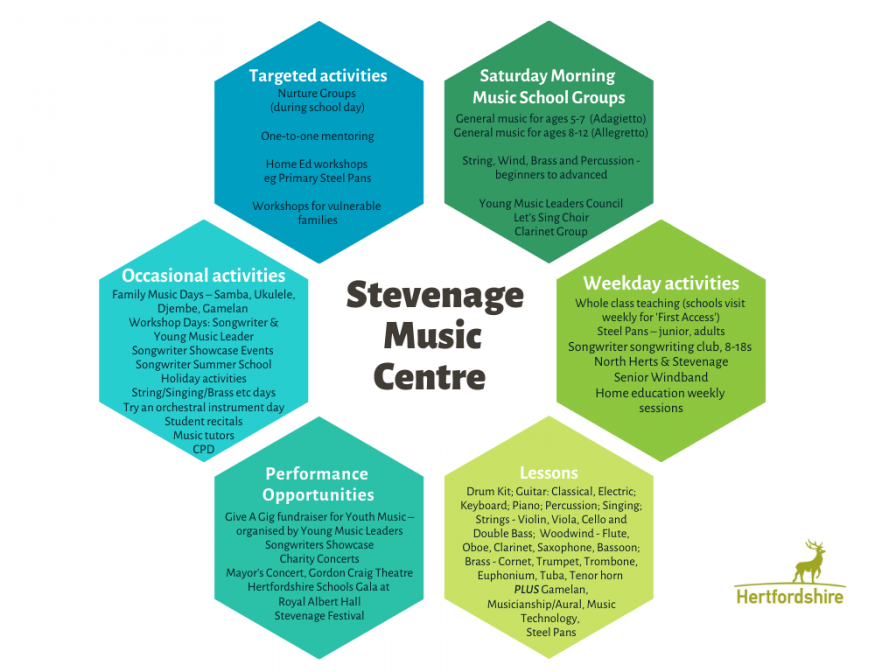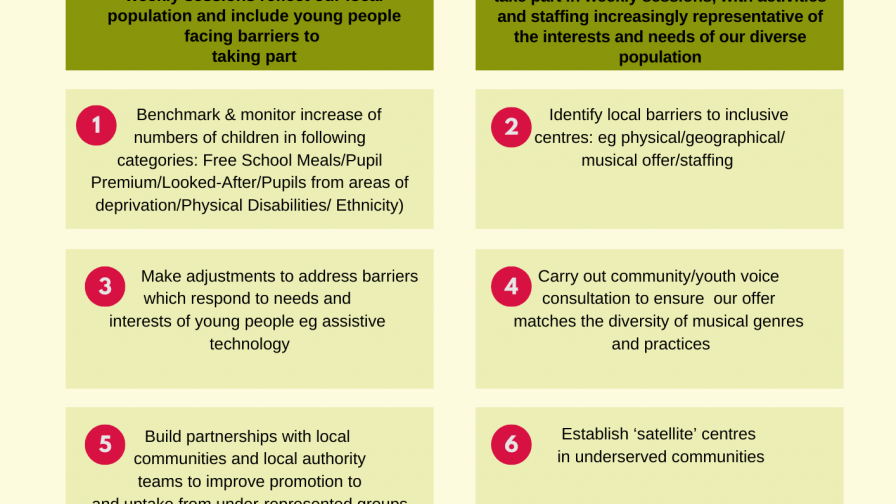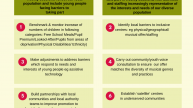Creating a music centre for the whole community in Stevenage

We all know how important a music centre can be to a young person. It’s a place where they forge friendships, develop as people, and learn skills for learning and for life. In this interview with Christina Luchies, Head of Stevenage Music Centre, she explains how her team are creating a centre for the whole community, including adults, families and vulnerable young people. She talks about how this approach has also unlocked new partnerships, support and funding.
Stevenage Music Centre, part of Hertfordshire Music Service, has been based at the Nobel Secondary School, since 2013. Christina joined in 2015, having been head of music at an inner London secondary school, then head of performing arts at a Stevenage secondary school. Prior to that she had been a solo and orchestral performer in South Africa which she combined with classroom teaching.
Why is your Centre different to the traditional model of a music centre?
In many ways, it’s the same. We offer instrumental teaching and ensembles to young people and arrange performances here in the Centre and in the local community. But we also offer activities for adults and families, as well as a targeted programme of informal music education to prevent school exclusions and support young people in challenging circumstances. So it’s a really diverse community of music-makers.
What sort of activities do you offer? – see the main image
Who attends?
Around 376 young people attend each week, from three-year-olds taking part in String Babies, right through to students preparing for ABRSM exams, GCSEs and A-levels. Then there are also young and middle-aged parents in our family workshops and choirs, and a few adults including retired people who are learning an instrument for the first time. We have one lovely example of a mother and grandmother learning guitar together while their child comes for lessons.
Currently, around 6% of young people pay reduced price fees as a result of being in receipt of free school meals or other benefits.
We know we have a long way to go in terms of reflecting the local population: as 15.9% of under 16s in Stevenage Borough live in poverty.
How did you begin to broaden the offer at your music centre?
When I took up this post, I’d already worked with the music service through my school, running a rock school with them, and various inclusion projects. We started by looking at ways we could bring the young people who took part in the inclusion projects in schools, into the music centre.
Inclusion isn’t something you just talk about: you have to work hard to understand who may be facing barriers, and what you can do to break them down. You can’t just be so passionate about something, like music, that you’re blinded to the fact that many people can’t access it.
We’re lucky in Hertfordshire that we have a Youth Music-funded programme called MusicNet East – Changing Tunes, which is part of the Alliance for a Musically Inclusive England. So we looked at how we could bring that work into the Centre, rather than seeing it as a separate project.
We agreed that the point of a music centre is more than traditional ensembles, orchestras and choirs. We want to fill our practice rooms with young people and the many different types of music they want to make on their own and together, as a community. I would be asked “what are you doing to encourage more bassoon players, we’re running out!” To which I’d answer, “get young people in the music centre first so they can see one!”.
Why are you so committed to inclusion?
When I was a head of department, success for me was making sure that all pupils, but particularly those who were misbehaving or not turning up at school, saw the music department as somewhere for them. I wanted them to see music as an area where they could be successful.
Inclusion isn’t something you just talk about: you have to work hard to understand who may be facing barriers, and what you can do to break them down. You can’t just be so passionate about something, like music, that you’re blinded to the fact that many people can’t access it.
And inclusion can’t just be ‘tagged’ onto provision. It must underpin all provision.
What’s been the key to attracting a wide range of young people?
The more diverse the range of music and music learning you offer, the more young people will come through the door. But also, we started thinking, we need parents to experience the difference music can make – after all, it’s parents who make the final decision on whether a young person attends.
Our community-funded choir (free to all members) is open to any 7-18 year-olds who took part in one or more paid-for activity. We now also host intergenerational mornings, open to parents, grandparents and family members, and it’s really diverse culturally. We now have 60 students on our books. Students and family members fundraise for the choir, with anything from a marathon to a cake sale.
We agreed that the point of a music centre is more than traditional ensembles, orchestras and choirs. We want to fill our practice rooms with young people and the many different types of music they want to make on their own and together, as a community.
We then decided to run Family Music workshops, to bring in new families and help us to get to know them, beginning with junk percussion, led by community musician Mark Howe (see the videos here: promo video - and reflections.
Since then music centre tutors have delivered samba, ukulele, steel pans and gamelan. They always sell out now. The County’s Intensive Family Support Team also pay for vulnerable families to take part, when they identify that someone has an interest in music. Sometimes we run sessions just for these families. Schools are interested in this too, in terms of how they can engage ‘hard to reach’ families. Children from these, and other targeted programmes often move into other areas of our provision.
The other key to our success is giving young people a voice in the centre. We have a Stevenage Young Music Leaders group, and they get involved in community music leadership training, offering suggestions for how the music service can better engage young people, running the Hertfordshire Youth Music Give a Gig, being ambassadors and looking after VIPs at events and much more.
What evidence do you have that you’re attracting a more diverse range of young people?
That’s a question that we’re about to start addressing more rigorously. Like many music services, we’ve relied on ‘seeing’ the change, but we know that’s not good enough. So we now have KPIs specifically around inclusion and a set of related actions that we’ve committed to taking.
See an infographic of Stevenage Music Centre’s inclusion KPIs and actions below.
What has helped you to engage the wider community?
We run a lot of events like family concerts, and fundraising concerts for local charities. These are often themed around what the charities do, and we show films or slideshows to raise awareness of their work.
We also know that it’s important not to expect people to come to us, but to go out to them too. So for example we work with social workers in children’s homes to identify young people interested in music, and provide one-to-one mentoring-style lessons at their home.
I’m really proactive about building links and developing relationships. I now know all the music leads in the schools in the areas – we bring together primary and secondary schools’ networks once or twice a term – and we send promotional information to them too. Some are very proactive and will pay for individual children to attend, provide transport etc, because they know what an impact it makes to be part of the Centre.
We also link up with other professionals who may be a route to reaching those who usually miss out. I’ll invite them in to discuss with me what we need to do to support and encourage the young people they work with. We’ve also worked in this way with the Home Education community as well as special needs schools.
If I can’t support my community, how can they support me? If I don’t take my centre into the community, how will they know I’m here?
Getting out there, and attending community meetings, is important. I attend the Borough Council cultural meetings and I’m a member of the Stevenage Festival Committee. Through these commitments I’ve got to know all sorts of people. We’ve been invited to perform at events such as the launch of the Cultural Strategy and the switching on of the Christmas lights – but we make sure we, and our staff, are paid and are clear about those costs, ranging from transport to rehearsals. If people offer us an opportunity, we make it happen. If I can’t support my community how can they support me? If I don’t take my centre into the community, how will they know I’m here?
What impact has this broader approach had on your tutors and other staff?
Early on, when we first started our inclusive nurture groups [more on this in a separate blog, see below], we offered training from a trauma therapist to all Music Centre staff – not just those doing the targeted inclusion work. They all really loved it, and enjoyed the opportunity to extend their skills. Across the music service, we’re continuing to offer those sorts of opportunities to all tutors as much as possible.
One of the other key things is that staff have ownership and autonomy. It’s important that they feel able to be responsive to the people they work with, and also to their own passions and interests. They have my blessing to explore new approaches, to test if they’ll work. That might range from setting up a new group to quite simply trying different repertoire. Young people also have quite a bit of input, particularly into repertoire for the choir, where older pupils work alongside the workshop leader.
I think that doing the work on the ground and getting it to the point of success does its own PR job. Then people ask, how did you get 27 new people in your centre for a family workshop? And I say, “four years of hard grafting!”
The Centre now has a really lively, community feel, and that makes everyone feel positive about it.
What impact has it had on your music centre as a business?
Inclusion can’t just be ‘tagged’ onto provision. It must underpin all provision.
One of the Centre’s Key Performance Indicators is to increase business by five per cent. People might think that doesn’t sit well with inclusion: the impact of ‘going the extra mile’ for inclusion can be difficult to quantify.
We also have to make some decisions that might seem contrary to ‘business’ practice. For example, we make our Songwriting sessions ‘drop-in’ rather than asking people to commit to the term. We don’t want children to come just because their parents say they have to. But it’s worked, because they do come!
We’ve also brought in new income streams by looking at who’s missing out, and then seeking partners to help reach them. For example, staff in a PRU where the Music Service were working told us they were part of a network of local schools’ headteachers working to prevent school exclusion from primary school upwards. We approached the network, called DSPL2 – Developing Special Provision Locally’, presented to them, and together we co-designed a schedule of inclusive instrumental teaching across key stages, made up of Nurture Groups and one-to-one music mentoring. They gave us £11,000 in match funding, and now some schools have gone on to sign up for Whole Class Ensemble teaching. We had a Nurture Group day in the centre in March, and are looking forward to welcoming pupils into our weekly centre activities.
We know that music is valued by the County Council and by others in our county working with young people. It’s helped a wide range of people to recognise the importance and value of music to the young people they work with, as well as to the community, and that’s priceless.
Hertfordshire Music Service is a founder member of the Alliance for a Musically Inclusive England (AMIE). Its MusicNet East Changing Tunes programme (new website coming soon) helps music services to become more inclusive by providing a peer network, resources and tools, and funding for action research on the barriers and drivers to inclusion. Visit the AMIE Musical Inclusion Resource Hub for tools and guidance, blogs, videos, case studies and more, to help you break down barriers to music-making.
FURTHER READING/VIEWING FROM OTHER AMIE PARTNERS
[VIDEO] Supporting Musical Communities – part of the Practical Progression series from Awards for Young Musicians



